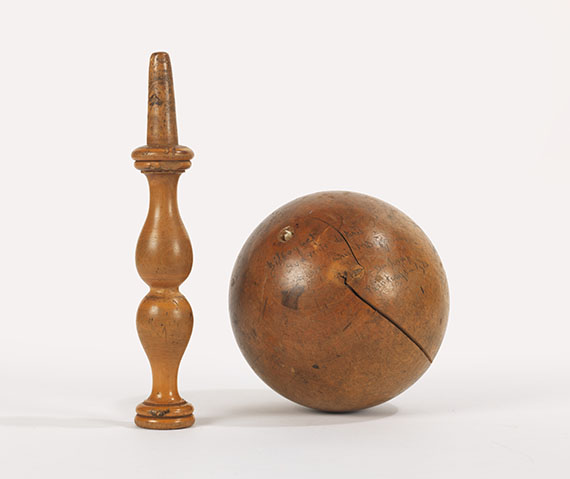Dictionary


Surrealism of the Breton group
Surrealism in Paris is often strongly associated with the term "Breton Surrealism". Indeed, the founding father of Surrealism, the writer and art critic André Breton (1896-1966), was the movement's dominating and decisive figure.
His first work "Manifesto of Surrealism" from 1924 fixes the new movement. In the writing he stresses the "automatism" that is to express the unconscious. Half a decade later André Breton wrote the second Manifesto of Surrealism, in which he asked for a mystic mysteriousness.
Literature clearly marked the beginning of the Breton group's Surrealism, painting was only gradually added, in the first manifesto from 1924 it was only marginally regarded. André Breton saw the completion of surrealist painting achieved in Max Ernst's collages and frottages and their principle of "combinatorics". Numerous further groundbreaking methods - dripping, decalcomania, grattage, fumage and several other - were developed by the Paris surrealists. The movement cannot be characterized by a unified style, a certain spontaneity can only be stated for the early years (Automatism and Absolute Surrealism), which lead to the artistic meticulousness of a verist Surrealism with Salvador Dalí, René Magritte and Yves Tanguy in the late 1920s.
The Breton group consisted of varying members, among them Max Ernst, Jean Arp, Antonin Artaud and André Masson. But representatives of New York Dadaism such as Francis Picabia, Man Ray and Marcel Duchamp counted among the surrealists. Jean Arp, Giorgio de Chirico, Paul Klee, Max Ernst, André Masson, Joan Miró and Pablo Picasso showed works in the first surrealist exhibition in 1925.
Parisian Surrealism, on which André Breton kept a vigilant eye, went through hard times every now and then, which was largely due to its founding father's dominance, but mostly for its genuinely political and ideological orientation. Struggles regarding intensity and focus of the political direction of Surrealism led to numerous exclusions, for instance of Antonin Artaud and Philippe Soupault, who were dismissed in 1927. Robert Desnos and Michel Leiris left the group in 1928 and 1929 respectively. Georges Bataille tried to establish an own group of surrealists in 1929/30. Two years later, Louis Aragon left the Breton group, Paul Éluard broke with the group in 1938, and also Max Ernst would soon leave the Paris surrealists. Certainly, new artists, such as Victor Brauner or Roberto Matta, joined the group.
Important exhibitions in Paris (1936, 1938) structured the 1930s, which marked the heyday of Surrealism. World War II put an end to this development, as many members of he Breton group went into exile and thus contributed to the spread of Surrealism all over the world. After the war André Breton tried to revive Paris Surrealism up until his death in 1966.
Surrealism in Paris is often strongly associated with the term "Breton Surrealism". Indeed, the founding father of Surrealism, the writer and art critic André Breton (1896-1966), was the movement's dominating and decisive figure.
His first work "Manifesto of Surrealism" from 1924 fixes the new movement. In the writing he stresses the "automatism" that is to express the unconscious. Half a decade later André Breton wrote the second Manifesto of Surrealism, in which he asked for a mystic mysteriousness.
Literature clearly marked the beginning of the Breton group's Surrealism, painting was only gradually added, in the first manifesto from 1924 it was only marginally regarded. André Breton saw the completion of surrealist painting achieved in Max Ernst's collages and frottages and their principle of "combinatorics". Numerous further groundbreaking methods - dripping, decalcomania, grattage, fumage and several other - were developed by the Paris surrealists. The movement cannot be characterized by a unified style, a certain spontaneity can only be stated for the early years (Automatism and Absolute Surrealism), which lead to the artistic meticulousness of a verist Surrealism with Salvador Dalí, René Magritte and Yves Tanguy in the late 1920s.
The Breton group consisted of varying members, among them Max Ernst, Jean Arp, Antonin Artaud and André Masson. But representatives of New York Dadaism such as Francis Picabia, Man Ray and Marcel Duchamp counted among the surrealists. Jean Arp, Giorgio de Chirico, Paul Klee, Max Ernst, André Masson, Joan Miró and Pablo Picasso showed works in the first surrealist exhibition in 1925.
Parisian Surrealism, on which André Breton kept a vigilant eye, went through hard times every now and then, which was largely due to its founding father's dominance, but mostly for its genuinely political and ideological orientation. Struggles regarding intensity and focus of the political direction of Surrealism led to numerous exclusions, for instance of Antonin Artaud and Philippe Soupault, who were dismissed in 1927. Robert Desnos and Michel Leiris left the group in 1928 and 1929 respectively. Georges Bataille tried to establish an own group of surrealists in 1929/30. Two years later, Louis Aragon left the Breton group, Paul Éluard broke with the group in 1938, and also Max Ernst would soon leave the Paris surrealists. Certainly, new artists, such as Victor Brauner or Roberto Matta, joined the group.
Important exhibitions in Paris (1936, 1938) structured the 1930s, which marked the heyday of Surrealism. World War II put an end to this development, as many members of he Breton group went into exile and thus contributed to the spread of Surrealism all over the world. After the war André Breton tried to revive Paris Surrealism up until his death in 1966.
Offers for Surrealism
Headquarters
Joseph-Wild-Str. 18
81829 Munich
Phone: +49 89 55 244-0
Fax: +49 89 55 244-177
info@kettererkunst.de
Louisa von Saucken / Undine Schleifer
Holstenwall 5
20355 Hamburg
Phone: +49 40 37 49 61-0
Fax: +49 40 37 49 61-66
infohamburg@kettererkunst.de
Dr. Simone Wiechers / Nane Schlage
Fasanenstr. 70
10719 Berlin
Phone: +49 30 88 67 53-63
Fax: +49 30 88 67 56-43
infoberlin@kettererkunst.de
Cordula Lichtenberg
Gertrudenstraße 24-28
50667 Cologne
Phone: +49 221 510 908-15
infokoeln@kettererkunst.de
Hessen
Rhineland-Palatinate
Miriam Heß
Phone: +49 62 21 58 80-038
Fax: +49 62 21 58 80-595
infoheidelberg@kettererkunst.de
We will inform you in time.




